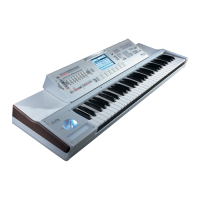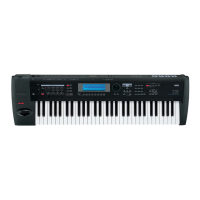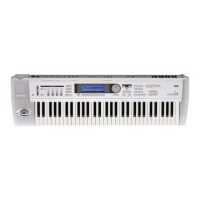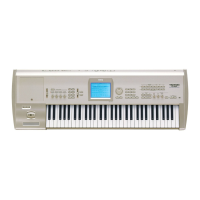PROG P0: Play Tone Adjust
19
CC# Assign [Off, 000...119]
This read-only parameter shows the MIDI CC sent by the
slider.
Value [000...127]
This is the current value of the slider’s MIDI CC.
Tone Adjust
Tone Adjust lets you use all of the sliders, and switches on
the Control Surface to edit Program parameters, like the
knobs on an analog synth. You can assign important
program parameters to these controllers.
Tip: In Combination and Sequencer modes, Tone Adjust also
lets you edit Program parameters without needing to save a
different version of the original Program. For more
information on Tone Adjust in these modes, please see
“Tone Adjust” on page 135 and page 212.
Absolute (Abs), Relative (Rel), Meta parameter
There are three kinds of Tone Adjust parameters: Absolute,
Relative, and Meta.
Absolute parameters usually control a single Program
parameter, such as Oscillator 1 Drive. The Program and
Tone Adjust parameters mirror one another; when you
change one, the other will change to match.
Relative parameters typically adjust two or more Program
parameters simultaneously. For instance, F/A EG Attack
Time affects a total of six Program parameters. The value of
the Relative parameter shows the amount of change to these
underlying Program parameters.
When the Relative parameter is at 0 (in the center of the
slider), the underlying Program parameters are unchanged.
The meanings of higher and lower settings can vary,
depending on the specific parameter. Unless noted
otherwise, they work as follows:
When the Relative parameter is at +99 (the maximum), the
Program parameters are all at their maximum as well.
Similarly, when the Relative parameter is at –99 (the
minimum), the Program parameters are at zero.
Relative Tone Adjust parameter scaling
A few of the Program parameters controlled by Relative
Tone Adjust are bipolar, meaning that they can be either
positive or negative (instead of just positive). When these
Program parameters are set to negative values, Tone Adjust
may behave differently from the description above.
For instance, if EG Intensity is set to a negative value,
Relative Tone Adjust will take it from 0 to –99, like the
0–8a
0–8g
0–8b
0–8
Menu
99
00
Relative Tone Adjust Value
Parameter
Value
As Programmed
0–99 +99

